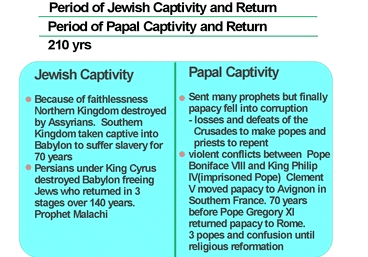 |
 |
The Period of Jewish Captivity and Return and the Period of Papal Captivity and Return
Not only the Northern Kingdom of Israel, which perished at the end of the period of the Divided Kingdoms because of its disbelief, but also the Southern Kingdom of Judah as well became faithless. They would not repent and failed to make the foundation for the coming of the Messiah, centering on God's ideal of the temple. Therefore, God allowed them to be taken captive into Babylon, the satanic world, to suffer slavery there for 70 years (Jer. 39:1-10, II Kings 24 and 25). In this period, King Jehoiachin, Daniel, members of royalty, government officials and many other Jewish people were taken captive by Nebuchadnezzar, the king of Babylon. Later, Persia destroyed Babylon and King Cyrus issued a decree freeing the Jews, who returned to their native land in three stages over a period of 140 years. There they set themselves up as the nation centering on the prophet Malachi to prepare for the Messiah.
From the end of the period of the Christian Kingdom, which was to prepare the foundation on the worldwide level for the Messiah's Second Coming, until the time when the papacy fell into corruption, God sent many signs, such as the losses and defeats of the Crusades, to make the popes and priests repent. But they did not and instead, with the gradual expansion of royal power, violent conflict grew between pope and king. Thus Pope Boniface VIII came 'into conflict with the French King Philip IV and was even imprisoned by him for a time. One generation later, Clement V moved the papacy from Rome to Avignon in Southern France. There the succeeding popes lived as captives for 70 years under the restraint of the French kings. This is the period of papal captivity. After that, Pope Gregory XI returned the papacy to Rome, but even after this there was much confusion as three popes reigned simultaneously for a period and other problems regarding papal authority occurred until the Religious Reformation began.